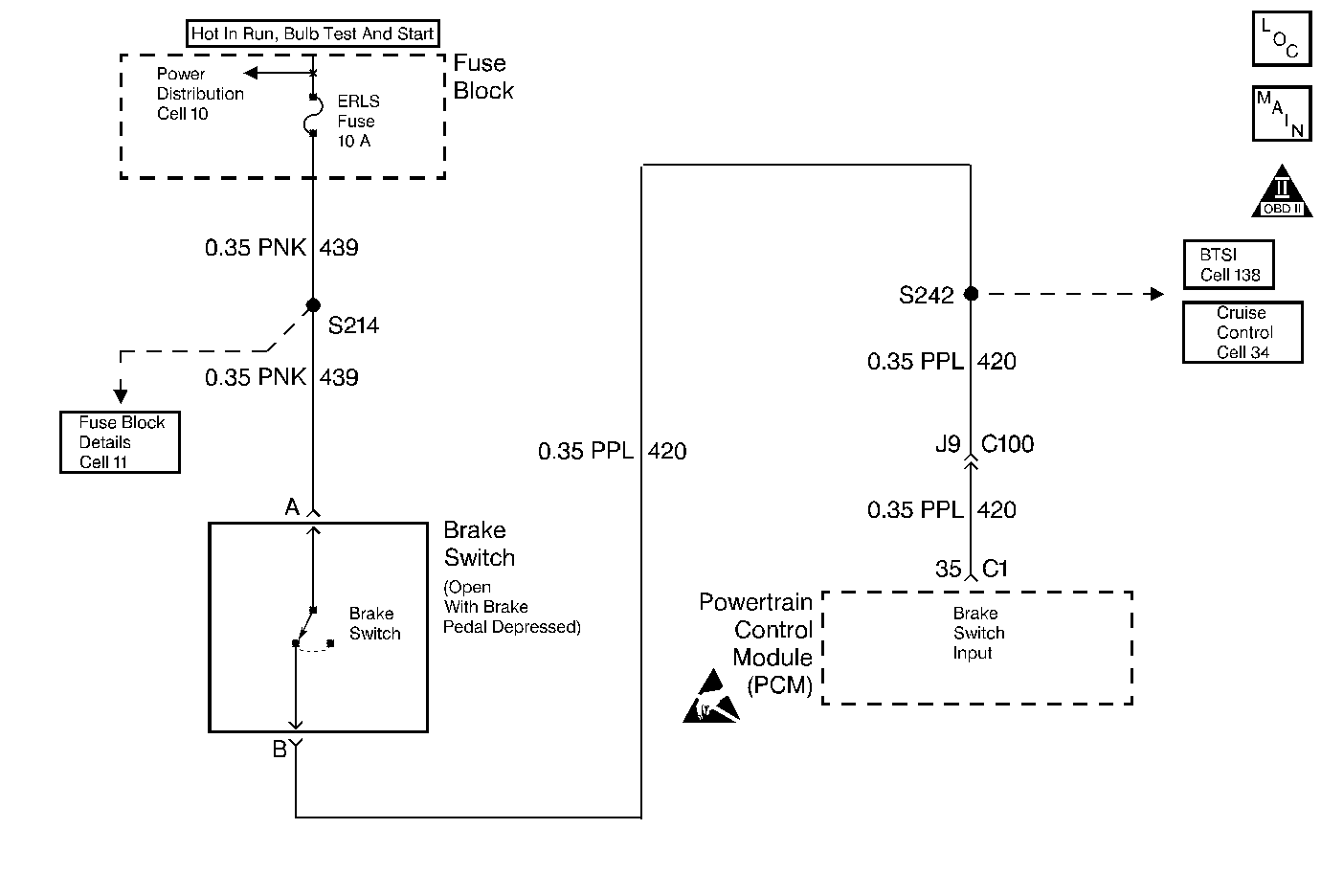
Circuit Description
The brake switch indicates brake pedal status to the Powertrain Control Module (PCM). The normally-closed switch supplies battery voltage on circuit 420 to the PCM. Applying the brake pedal opens the switch, interrupting voltage to the PCM. While the brake pedal is not applied, the PCM receives constant voltage. If the PCM receives 0 volts at the brake switch input with the Torque Converter Clutch (TCC) engaged, the PCM de-energizes the Torque Converter Clutch Solenoid Valve (TCC Sol. Valve).
When the PCM detects an open brake switch (stuck ON) during accelerations, then DTC P0719 sets. DTC P0719 is a type D DTC.
Conditions for Setting the DTC
| • | No Vehicle Speed Sensor Assembly DTCs P0502 or P0503. |
| • | The vehicle speed is less than 8 km/h (5 mph), |
| then the vehicle speed is 8-32 km/h (5-20 mph) for 4 seconds, |
| then the vehicle speed remains greater than 32 km/h (20 mph) for at least 6 seconds. |
| • | The above conditions must occur 6 times without a brake switch status change. |
Action Taken When the DTC Sets
The PCM does not illuminate the Malfunction Indicator Lamp (MIL).
Conditions for Clearing the DTC
A scan tool can clear the DTC from the PCM history. The PCM clears the DTC from the PCM history if the vehicle completes 40 warm-up cycles without a failure reported.
Diagnostic Aids
| • | Inspect the TCC brake switch for proper adjustment. |
| • | Inspect the wiring for poor electrical connections at the PCM. Inspect the wiring for poor electrical connections at the TCC brake switch connector. Look for the following conditions: |
| - | A bent terminal |
| - | A backed out terminal |
| - | A damaged terminal |
| - | Poor terminal tension |
| - | A chafed wire |
| - | A broken wire inside the insulation |
| • | When diagnosing for an intermittent short or open condition, massage the wiring harness while watching the test equipment for a change. |
Test Description
The numbers below refer to the Step numbers on the diagnostic table.
-
If you disconnect the brake switch connector and observe the brake switch status change, with the Jumper wire in place, then a brake switch is the only possible cause.
-
A short to ground in circuit 439 would open the ERLS fuse.
-
If the brake switch is properly adjusted, then you must replace the brake switch.
-
Replace the PCM only after you have completed the preceding diagnostic steps.
Step | Action | Value(s) | Yes | No | ||||||
|---|---|---|---|---|---|---|---|---|---|---|
1 | Was the Powertrain On-Board Diagnostic (OBD) System Check performed? | -- | ||||||||
Important: Before clearing the DTCs, use the scan tool in order to record the Failure Records for reference. Using the Clear Info function will erase the stored Failure Records from the PCM. Did the brake switch status change from Open to Closed? | -- | |||||||||
Refer to Troubleshooting Procedures, Section 8. Was the fuse open? | -- | |||||||||
4 | Inspect circuit 439 for a short to ground. Refer to Troubleshooting Procedures, Section 8. Did you find and correct the condition? | -- | -- | |||||||
Inspect the brake switch for proper adjustment. Refer to Brake and Clutch Pedal Switches, Section 8. Did you find and correct the condition? | -- | |||||||||
6 | Inspect circuit 439 for an open. Refer to Troubleshooting Procedures, Section 8. Did you find and correct the condition? | -- | ||||||||
7 | Replace the brake switch. Refer to Brake and Clutch Pedal Switches, Section 8. Is the replacement complete? | -- | -- | |||||||
8 | Inspect circuit 420 for an open. Refer to Troubleshooting Procedures, Section 8. Did you find and correct the condition? | -- | ||||||||
Replace the PCM. Refer to Powertrain Control Module/EEPROM Replacement/Programming , Section 6. Is the replacement complete? | -- | -- | ||||||||
10 | In order to verify your repair, perform the following procedure:
Has the test run and passed? | -- | System OK |
